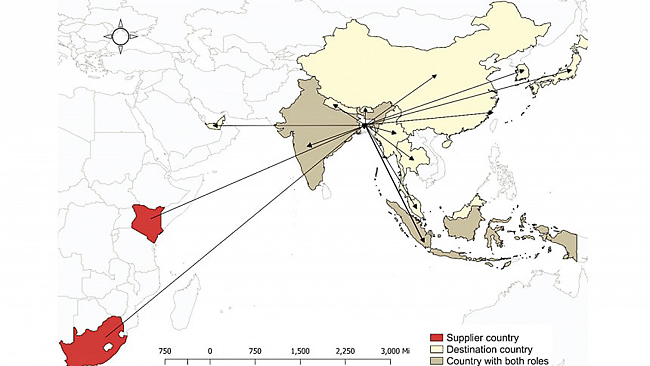ANN/THE DAILY STAR – The Patagonian Mara, resembling a rabbit but also akin to a deer, inhabits open and semi-open environments across Argentina, notably in extensive regions of Patagonia. This herbivorous mammal is a distinctive presence in these habitats, yet it is not typically observed in other parts of the subcontinent.
But in March 2021, border guard members recovered seven of these near-threatened animals from some abandoned sacks in Tushkhali border area in Kolaroa upazila of Satkhira.
The following year, a large number of wild animals, including Hoolock gibbons, porcupines, fishing cats, leopard cats and Kalij pheasants were rescued from Lohagara upazila, Chattogram. Latest in January last year, two bear cubs were rescued from Chokoria, Cox’s Bazar.
Earlier, law enforcers rescued nine zebras from a cow-shed near Sharsha border in Jashore in 2018, and two lion cubs and a leopard in 2017, also from Jashore.
This means, many exotic and endangered species continue to be smuggled into Bangladesh from Africa and South America, as the country remains a transit hotspot for wild-life trafficking.
Forest officials sent all these recovered and rescued animals to Bangabandhu Safari Park in Gazipur, but could not identify the traffickers or the final destination of these animals.


Forest officials, wildlife crime control officials and researchers said that all those exotic animals from South America and Africa were rescued by the Indian border, indicating that they were brought into Bangladesh to be trafficked to India.
“Wildlife being smuggled out of Bangladesh is not a new thing. But analysing all those animals and information from our field research, we can clearly say Bangladesh is also being used as a wildlife trafficking route,” leading researcher of wildlife trafficking in Bangladesh Nasir Uddin told The Daily Star.
He said Bangladesh now plays the role both as a source of and a transit route for wildlife trafficking. It is also a consumer of many wildlife species.
WILDLIFE TRAFFICKING FROM BANGLADESH
A study by Nasir Uddin and other researchers titled Exploring market-based wildlife trade dynamics in Bangladesh found that different Asian countries, including Thailand, Singapore, China, Malaysia, Vietnam, Laos and Myanmar have a demand for Bangladeshi wildlife.
The study, published in Cambridge University Press journal in November 2022, surveyed 13 wildlife markets across Bangladesh and identified 421 traders selling wildlife.
Another research titled Laundered alive? The transnational trade in wild felids through Bangladesh published in December 2022 found that various tiger-products are trafficked from Bangladesh to 13 countries in Asia, Europe and Australia.
Citing anonymous wildlife traders, the study report, co-authored by Nasir Uddin, said South Africa, India, Indonesia and Kenya are the four main countries that export live felids (mammals of cat families) to Bangladesh.
It also identified 15 countries that receive live wildlife from Bangladesh, including four countries in the Middle East, four in South Asia, four in Southeast Asia, and three in East Asia.
“India is the top destination of live felids from Bangladesh followed by Myanmar, China and Malaysia,” the report said.
During interviews for the study, at least eight wildlife traders said traffickers smuggle both native and exotic felids to India from Bangladesh.
Citing wildlife traders, the study said traffickers sometimes use forged permits from Convention on International Trade in Endangered Species of Wild Fauna and Flora (CITES) to first smuggle wildlife into Bangladesh for eventually trafficking them to other countries.
Interviewees described live wildlife being imported and exported by air via Dhaka and Chattogram airports. But they use land border to traffic those to India and Myanmar.
Both the studies by Nasir Uddin and others identified 16 points along the Bangladesh-India and Bangladesh-Myanmar borders that are used to traffic wildlife to neighbouring countries. These points include Banglabandh, Bhurungumari, Benapole, Teknaf, Chattogram seaport and Tamabeel.
A separate study published in November last year by Wildlife Justice Commission found tiger cubs are brought to Bangladesh from Thailand.
An Interpol report released in 2016 said traffickers export different tiger parts to Myanmar, Malaysia, China and Korea through Dhaka airport with consignments of frozen food.
Nasir Uddin said he analysed export data from the CITES website in 2022 and found exporting countries declared 188 felids export to Bangladesh. Of these, Bangladesh reported only four imports. On the other hand, Bangladesh declared 16 more imports that were not reported by any exporting countries.
He noted that most of these felids were trafficked to other countries via Bangladesh, and stressed the need for creating a digital database for legal wildlife imports.
